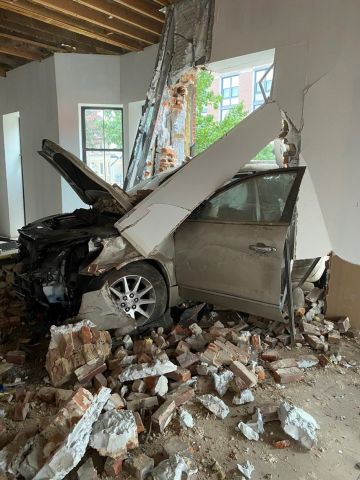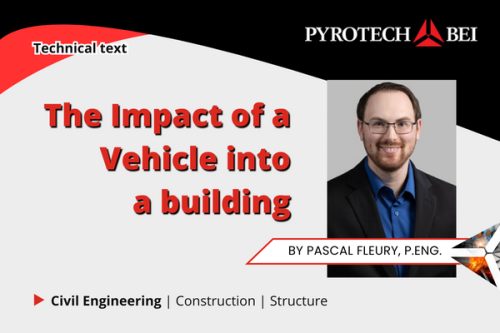LAVAL 1 800 361-0338
Lévis 1 866 835-5335
The Impact of a Vehicle into a Building
Accidents involving vehicles crashing into buildings are unfortunately more common than one might think. Such examples include a driver’s error of inattention, who confuses the brake for the accelerator and crashes into the façade of a building, or a sudden mechanical problem that renders the vehicle uncontrollable and that ultimately crashes into a building. These incidents can cause considerable damage to buildings
 In this brief article, we will touch on the role of a civil engineer as well as the type of opinion that he or she can issue to guide the file (preventive measures and determination of whether or not the damaged structures should be preserved), the alleged damage control (pre‑existing or non-existing damage) and the preventive measures to be taken. Typically, an engineer will be mandated to assess the extent of the structural damage and, if necessary, will recommend temporary measures to ensure the safety of the site if required.
In this brief article, we will touch on the role of a civil engineer as well as the type of opinion that he or she can issue to guide the file (preventive measures and determination of whether or not the damaged structures should be preserved), the alleged damage control (pre‑existing or non-existing damage) and the preventive measures to be taken. Typically, an engineer will be mandated to assess the extent of the structural damage and, if necessary, will recommend temporary measures to ensure the safety of the site if required.
To that end, it is essential to ensure beforehand that the structure is stable and safe in order to assess the damage. Alternatively, if a part of the structure is heavily damaged and cannot be secured or that it is not economically feasible to stabilize it, an engineer may recommend its demolition. Once safety measures have been taken, the investigation can be pursued.
In order to determine the extent of damage caused by a vehicle impact, the examination of the structural/load-bearing elements is necessary. If needed, the finishes could be removed to reveal the support structures in the vicinity of the impact site. Any structural movement, cracks, damage, or other signs of movement should be carefully examined and analyzed to identify the area where the forces transmitted to the structure propagated and potentially affected the integrity of the structure. The engineer responsible for this type of investigation will be able to provide a detailed summary of the damage as well as repair instructions, including details on the elements to be replaced/repaired, which will permit to rebuild the structure according to its original characteristics.
As part of the investigation, the engineer should be able to identify, in most cases, if some are pre-existing damage or related to the impact. It is normal that a homeowner can become suspicious of cracks or damage of any kind, whereas these could have possibly been present even before the impact. In such cases, the engineer can often differentiate between new and pre‑existing damage by means of an objective and factual demonstration of its origin. This is usually done by assessing visual aspects of the damage[1] in connection with the analysis of the structural behaviour following simulation of the consequences of the impact.
In summary, regardless of the circumstances, Pyrotech BEI’s team can help you determine and assess the structural damage of the building affected by the impact of a vehicle and can undoubtfully guide you in the best way to repair it.
[1] The appearance of material deformations and certain time markers (paint, dust, plaster, previous repairs, etc.) are some of the indicators that can be used to locate the origin in time of some damage.
By Pascal Fleury, P.Eng.
Civil Engineering Department | Construction | Structure


